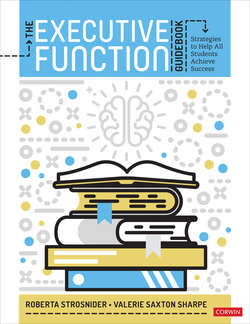Читать книгу The Executive Function Guidebook - Roberta Strosnider - Страница 12
На сайте Литреса книга снята с продажи.
What is Executive Functioning (EF)?
ОглавлениеExecutive functioning is a group of processes that allows individuals to self-regulate the ways in which they interact with their environment. Executive function skills develop and improve throughout childhood and into young adulthood.
Executive functioning involves the metacognitive processes of making decisions, planning actions, and generating responses that are adaptive to environmental demands (Reynolds, Horton, & Decker, 2008). There are a variety of models for grouping executive function skills. Brown (2005) identified six clusters of executive functions, while McCloskey, Perkins, and Van Diviner (2001) listed eleven. Still other models group executive functions differently. In this book, we categorize executive function skill areas as follows (see figure 1.1):
FIGURE 1.1 Strosnider and Sharpe Executive Function Categories
Working Memory
Prioritizing, Organizing, Sequencing, Managing Time, and Planning
Attending, Initiating, and Focusing
Controlling Social/Emotional Behaviors and Impulses
Communicating, Cognitive Flexibility/Shifting
The umbrella in figure 1.1 provides a visual of the EF categories as we organize and present them in this book. Each spoke of the umbrella includes a group of executive functions connected to chapters in the book. The EFs from left to right are covered in detail in the same sequence in chapters 2 through 6.
Executive function deficits are recognized in the DSM-5, and we know executive function (EF) deficits may lead to a plethora of inappropriate school and social behaviors. Dawson and Guare (2009) describe students with EF deficits as “smart but scattered.” Researchers at the Child Mind Institute (2015) propose that executive function deficits occur two ways: externally and internally. The student has difficulty externally with behaviors and internally with thinking and learning. External behaviors associated with EF deficits may include losing assignments before turning them in, seemingly not focusing, and not getting started on tasks. Internal behaviors may include difficulty understanding what is expected, problems with taking notes, and/or problems determining what is important in a written passage. Table 1.1 outlines some signs of executive functioning deficits presented by children and adolescents.
TABLE 1.1
If the student is demonstrating many of the descriptors, the next step is to provide intervention. You will find information on interventions throughout this book. As mentioned earlier, executive functions are intertwined and a student may exhibit difficulties in multiple categories. If the interventions are not effective, formal evaluation by a qualified professional may be necessary.
